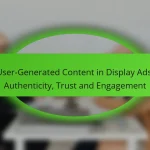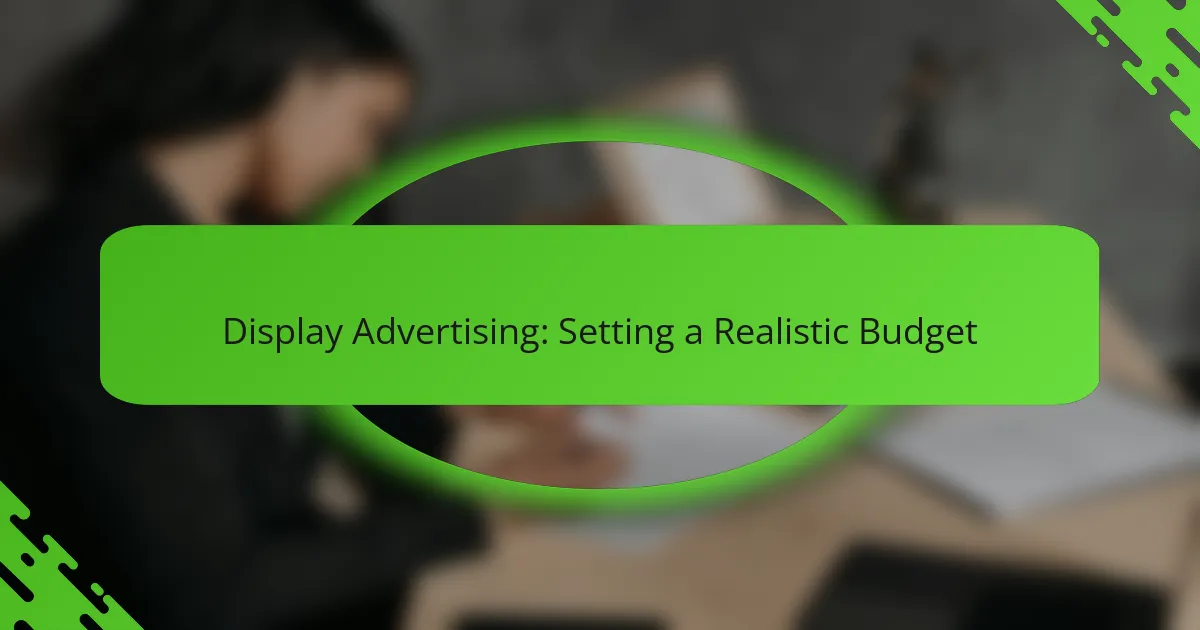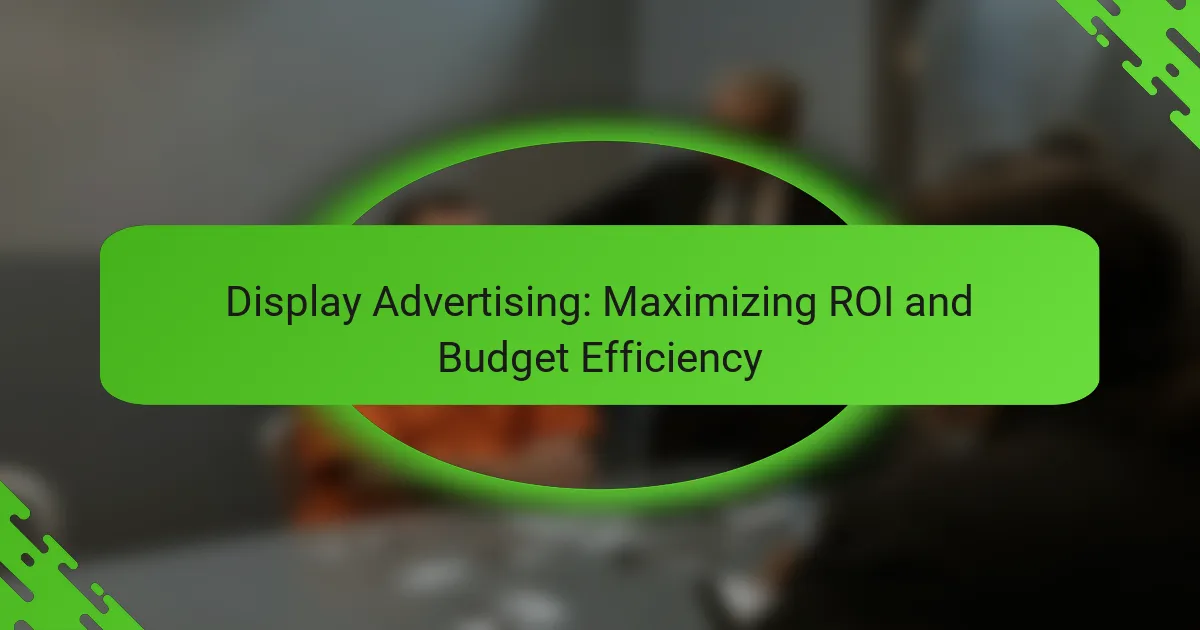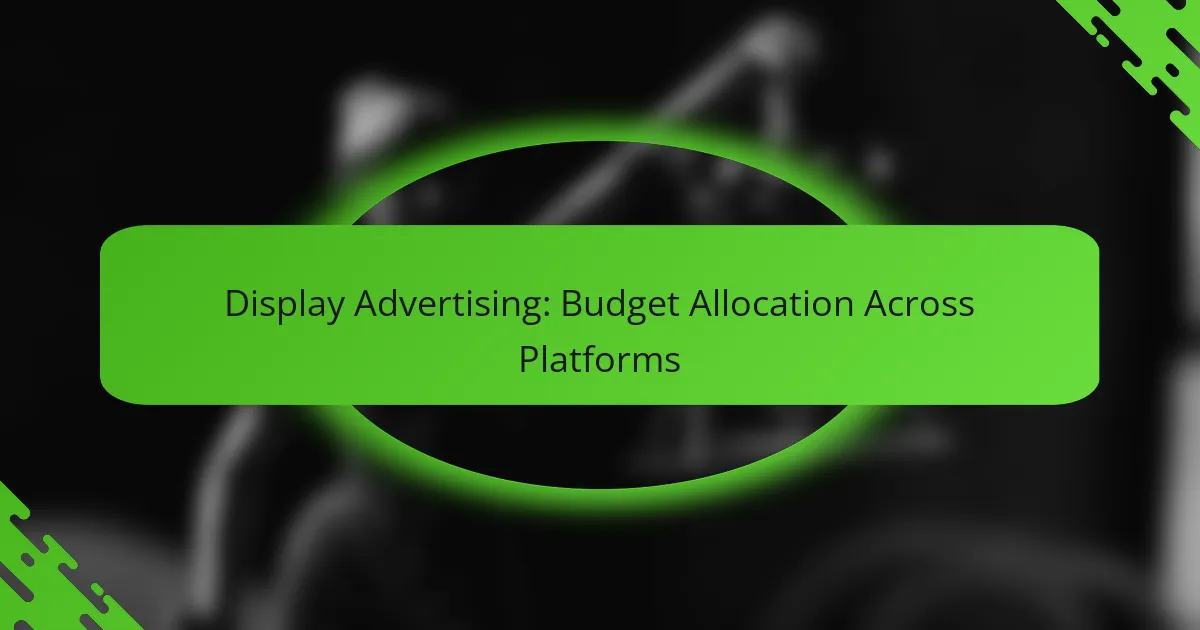In the realm of online advertising, understanding the differences between Cost-Per-Click (CPC) and Cost-Per-Impression (CPI) is essential for optimizing campaign performance. CPC charges advertisers only when users engage with their ads by clicking, making it ideal for driving traffic. Conversely, CPI focuses on maximizing ad visibility by charging for each impression, regardless of clicks, which is beneficial for building brand awareness. Choosing the right model depends on your specific marketing objectives and desired outcomes.
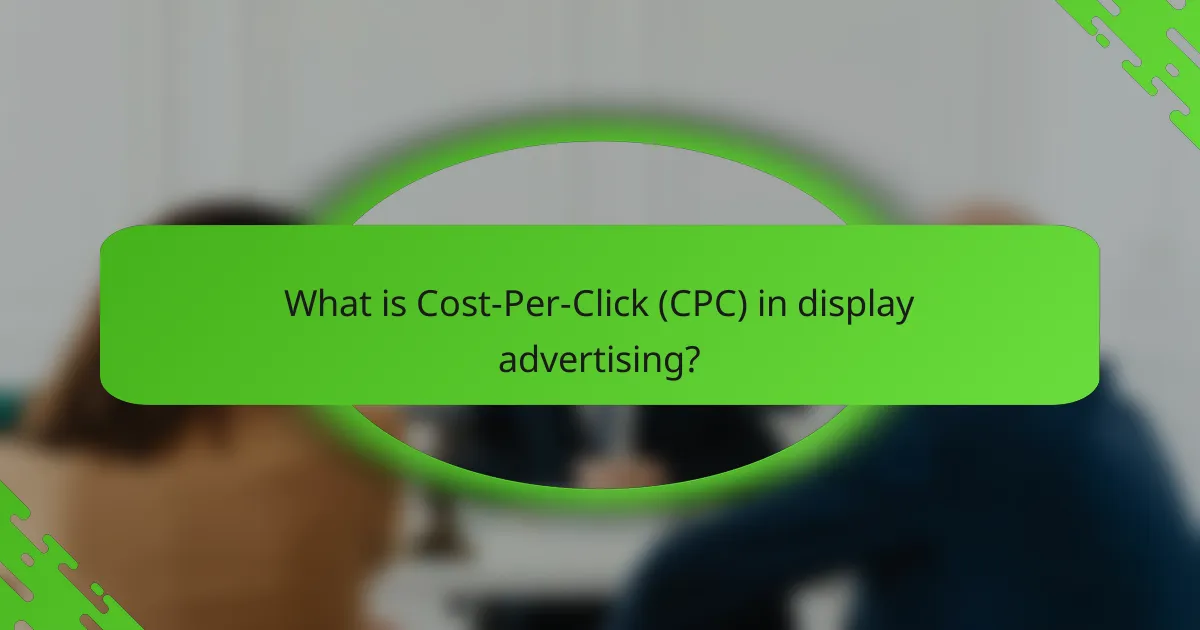
What is Cost-Per-Click (CPC) in display advertising?
Cost-Per-Click (CPC) in display advertising is a pricing model where advertisers pay each time a user clicks on their ad. This approach allows businesses to drive traffic to their websites while only incurring costs when actual engagement occurs.
CPC definition
CPC is a digital advertising model that charges advertisers based on the number of clicks their ads receive. It is commonly used in pay-per-click (PPC) campaigns, where the focus is on generating immediate traffic rather than just impressions. Advertisers set a maximum bid for how much they are willing to pay for each click, which can vary based on competition and targeting.
Benefits of CPC
One of the primary benefits of CPC is that it ensures advertisers only pay for actual engagement, making it a cost-effective option for driving traffic. Additionally, CPC campaigns can be easily tracked and optimized, allowing advertisers to measure performance and adjust bids based on results. This model also provides flexibility in budget management, as advertisers can set daily or monthly spending limits.
Another advantage is that CPC can lead to higher conversion rates since users clicking on ads are often more interested in the product or service being offered. This targeted approach can yield better returns on investment compared to other models like Cost-Per-Impression (CPI).
When to use CPC
CPC is ideal for campaigns focused on generating immediate traffic or conversions, such as product launches or promotional offers. It is particularly effective for businesses with a clear call to action, where the goal is to drive users to a landing page or online store. If your advertising strategy emphasizes measurable outcomes, CPC is a suitable choice.
However, it is essential to monitor your CPC campaigns closely to avoid overspending. Setting clear goals and regularly analyzing performance metrics can help ensure that your CPC strategy remains effective. Avoid using CPC for brand awareness campaigns where impressions are more valuable than clicks, as this may lead to wasted budget on low-engagement ads.
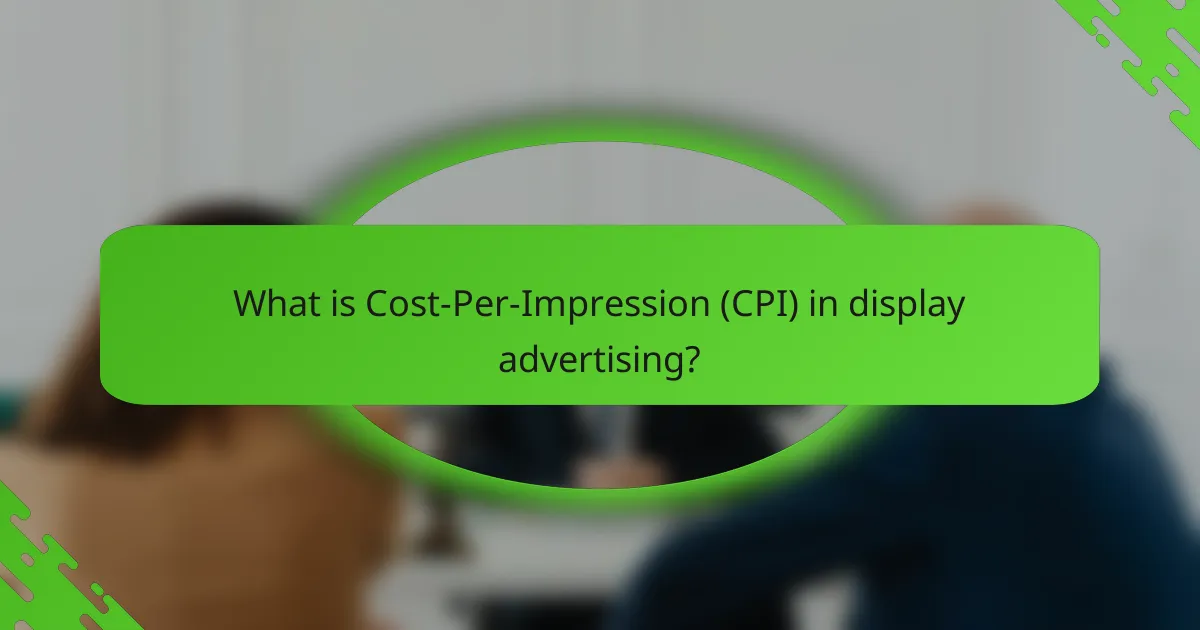
What is Cost-Per-Impression (CPI) in display advertising?
Cost-Per-Impression (CPI) is a pricing model in display advertising where advertisers pay for each time their ad is shown, regardless of whether it is clicked. This model focuses on maximizing visibility and brand awareness rather than immediate user action.
CPI definition
CPI refers to the cost incurred by advertisers each time their advertisement is displayed to users. It is commonly used in online advertising campaigns where the goal is to reach a broad audience. Advertisers typically calculate CPI by dividing the total cost of the ad campaign by the number of impressions served.
Benefits of CPI
One of the main benefits of CPI is that it allows advertisers to build brand awareness effectively by ensuring their ads are seen by a large number of potential customers. This model is particularly advantageous for campaigns aimed at promoting new products or services, as visibility can lead to increased recognition and recall.
Additionally, CPI can be more cost-effective for advertisers targeting a wide audience, as it often results in lower costs per impression compared to other models like Cost-Per-Click (CPC). This can be especially beneficial for businesses with a limited budget looking to maximize their reach.
When to use CPI
CPI is best used when the primary goal of an advertising campaign is to increase brand visibility rather than drive immediate conversions. For example, launching a new product or entering a new market can benefit from a CPI approach to ensure maximum exposure.
Advertisers should also consider using CPI when their target audience is broad and diverse, as this model allows for reaching various demographics without the need for immediate engagement. However, it is important to monitor the effectiveness of the campaign to ensure that the impressions are translating into meaningful engagement over time.
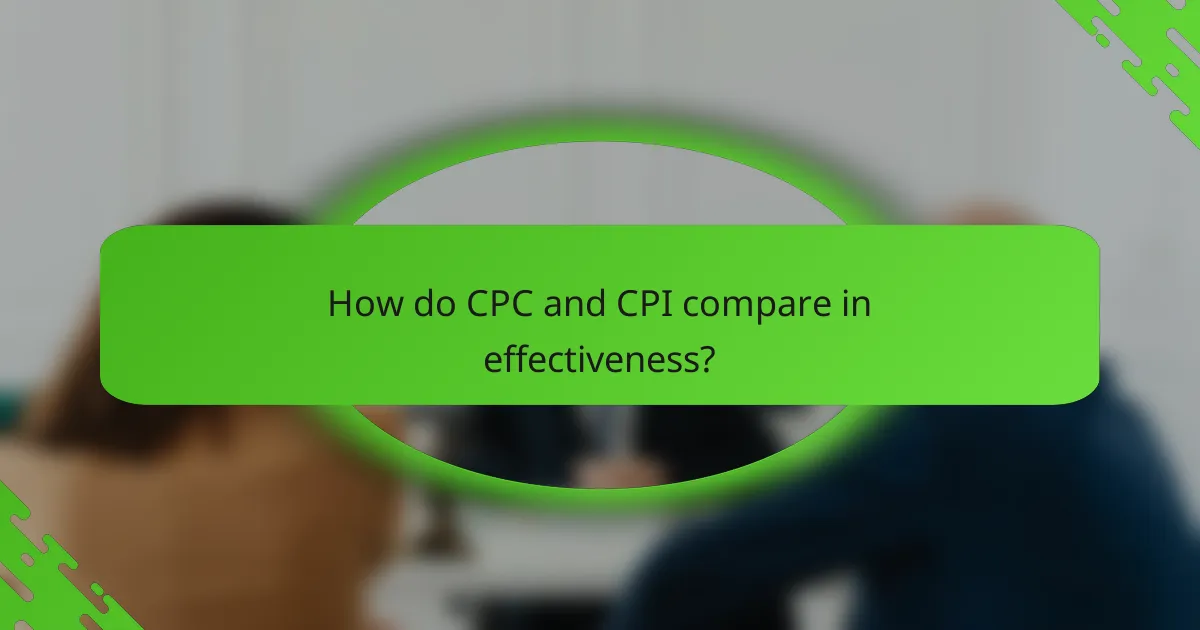
How do CPC and CPI compare in effectiveness?
CPC (Cost-Per-Click) and CPI (Cost-Per-Impression) are two distinct pricing models used in online advertising, each with its own effectiveness depending on campaign goals. CPC focuses on driving traffic through clicks, while CPI emphasizes brand visibility through impressions, making the choice between them crucial for achieving desired outcomes.
CPC vs. CPI performance metrics
CPC metrics typically measure the cost associated with each click on an ad, making it easier to assess direct engagement and conversion potential. Advertisers often find that CPC campaigns yield higher ROI when the goal is to drive specific actions, such as purchases or sign-ups.
In contrast, CPI metrics gauge the cost per thousand impressions, which is beneficial for campaigns aimed at brand awareness. This model allows advertisers to reach a broader audience, but it may not directly correlate with immediate user actions, making it essential to evaluate overall brand lift and engagement.
Target audience engagement
When targeting an audience, CPC is often more effective for campaigns focused on immediate engagement, as it incentivizes advertisers to create compelling ads that encourage clicks. This model suits businesses looking to convert leads quickly, particularly in competitive markets.

When should advertisers choose CPC over CPI?
Advertisers should choose Cost-Per-Click (CPC) when their primary goal is to drive traffic to a website or landing page. CPC is effective for campaigns focused on conversions, as it allows advertisers to pay only when a user clicks on their ad, ensuring that budget is spent on engaged users.
Best scenarios for CPC
CPC is ideal for campaigns aimed at generating leads or sales, where the advertiser wants to ensure that their budget is directed towards users who show genuine interest. It works well for search engine marketing and display ads where the intent to click indicates a higher likelihood of conversion.
Additionally, CPC is beneficial when advertisers have a clear understanding of their target audience and can optimize their ads for specific keywords or demographics. This approach allows for better tracking of ROI and performance metrics.
Industry examples favoring CPC
In the e-commerce sector, businesses often utilize CPC to attract potential customers to their product pages, where the likelihood of making a purchase is higher. For instance, retailers may run CPC campaigns during holiday sales to maximize traffic and conversions.
Similarly, in the technology industry, companies may use CPC to promote software trials or demos, as the click indicates a user’s interest in exploring the product further. This method allows tech firms to effectively gauge user engagement and adjust their marketing strategies accordingly.

When should advertisers choose CPI over CPC?
Advertisers should choose Cost-Per-Impression (CPI) when brand visibility is a priority over direct engagement. CPI is particularly effective for campaigns aimed at building awareness, where the goal is to reach a large audience rather than drive immediate clicks.
Best scenarios for CPI
The best scenarios for using CPI include brand awareness campaigns, product launches, and events where visibility is crucial. In these cases, advertisers benefit from reaching a broad audience without focusing solely on immediate actions like clicks.
Another scenario is when targeting audiences with high potential for future engagement, such as retargeting users who have previously interacted with the brand. This approach allows advertisers to maintain visibility while nurturing interest over time.
Industry examples favoring CPI
Industries such as consumer goods and entertainment often favor CPI strategies. For instance, a new movie release may utilize CPI to ensure maximum exposure across various platforms, reaching viewers who might not click but are influenced by seeing the ads multiple times.
Similarly, retail brands launching seasonal promotions can use CPI to saturate the market with their ads, ensuring that potential customers are aware of their offerings during critical shopping periods. This strategy can lead to increased foot traffic and sales, even if not all impressions convert to clicks immediately.

What are the key factors influencing the choice between CPC and CPI?
The choice between Cost-Per-Click (CPC) and Cost-Per-Impression (CPI) hinges on several critical factors, including campaign objectives, budget constraints, and audience engagement strategies. Understanding these elements will help marketers select the most effective pricing model for their advertising efforts.
Campaign goals
Defining campaign goals is essential when deciding between CPC and CPI. If the primary objective is to drive traffic to a website or generate leads, CPC is often more suitable as it charges advertisers only when users click on their ads. Conversely, if brand awareness or visibility is the goal, CPI may be more appropriate, as it allows advertisers to pay for ad impressions regardless of user interaction.
For example, a brand launching a new product may prioritize impressions to build awareness, opting for CPI. In contrast, an e-commerce site looking to boost sales would likely favor CPC to ensure they pay only for engaged users.
Budget considerations
Budget plays a significant role in choosing between CPC and CPI. CPC campaigns can lead to higher costs if the ads receive many clicks but low conversion rates. Advertisers should monitor their click-through rates (CTR) and conversion rates to ensure they stay within budget while achieving desired results.
In contrast, CPI can be more cost-effective for campaigns with limited budgets, as it allows for broader reach without the risk of overspending on clicks that don’t convert. A practical approach is to set a clear budget and evaluate the expected return on investment (ROI) for each model before making a decision.
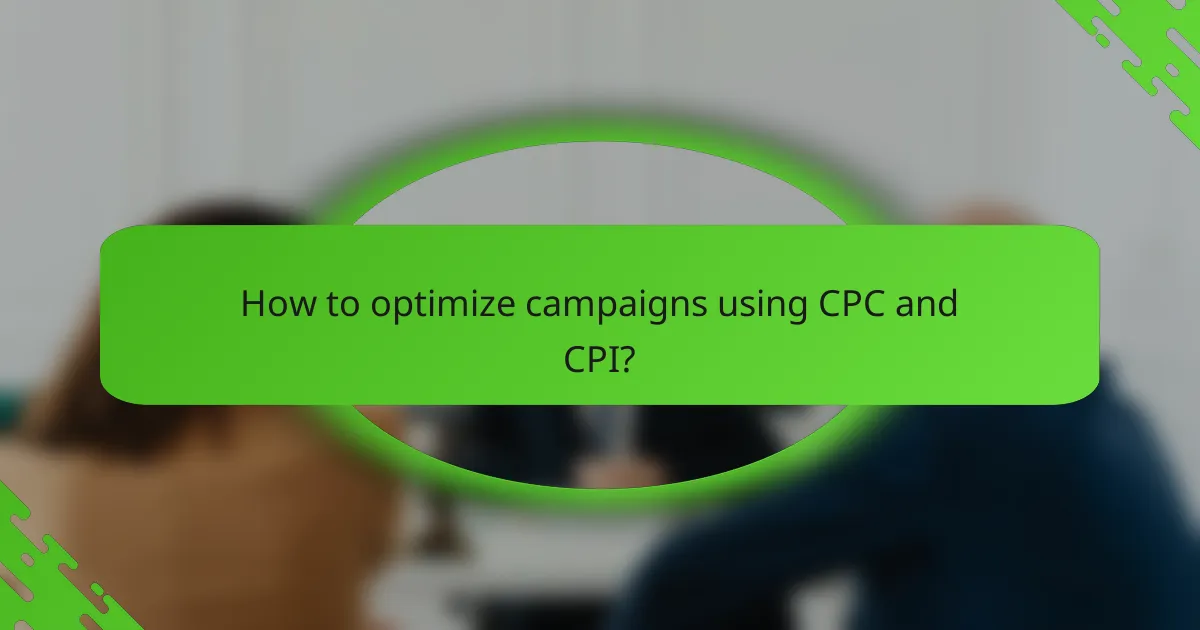
How to optimize campaigns using CPC and CPI?
To optimize campaigns using Cost-Per-Click (CPC) and Cost-Per-Impression (CPI), it’s essential to understand your campaign goals and audience behavior. CPC is typically better for driving traffic, while CPI can enhance brand visibility. Choosing the right model depends on your objectives and the nature of your product or service.
Understanding your goals
Defining your campaign goals is crucial when deciding between CPC and CPI. If your aim is to generate immediate traffic and conversions, CPC is often the preferred choice. Conversely, if you want to build brand awareness or reach a broader audience, CPI may be more effective.
Consider the lifetime value of your customers. If acquiring clicks leads to higher conversions, CPC might yield better returns. However, if your brand needs visibility in a competitive market, CPI can help establish presence without focusing solely on immediate clicks.
Analyzing audience behavior
Understanding your target audience’s behavior can guide your choice between CPC and CPI. Analyze metrics such as click-through rates (CTR) and conversion rates to determine which model aligns better with your audience’s preferences. For example, if your audience tends to engage more with visual ads, CPI could be advantageous.
Utilize tools like Google Analytics to track user interactions and refine your strategy. Look for patterns in how users respond to different ad types and adjust your campaigns accordingly to maximize effectiveness.
Testing and iteration
Continuous testing is key to optimizing campaigns using CPC and CPI. Start with a small budget to test both models and measure their performance. Monitor key performance indicators (KPIs) such as cost per acquisition (CPA) and return on ad spend (ROAS) to evaluate results.
Iterate based on your findings. If CPC ads are driving more conversions at a lower cost, consider reallocating budget from CPI to CPC. Conversely, if CPI ads are increasing brand awareness and engagement, they may warrant further investment.


